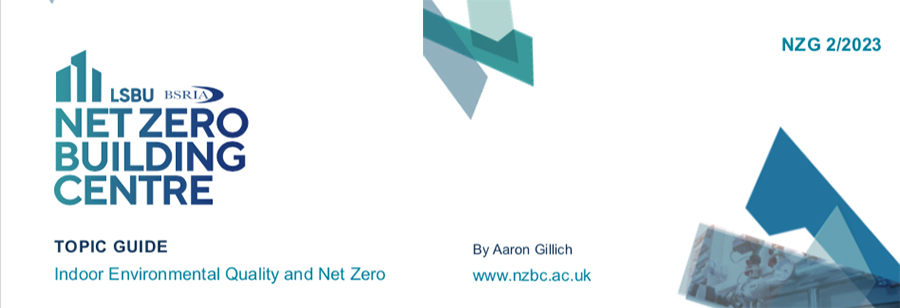Indoor Environmental Quality and Net Zero
Contents |
[edit] About the publication
Indoor environmental quality (IEQ) encompasses air quality and other quality metrics including acoustics, and thermal and visual comfort. This guide builds on these principles and applies them to the context of net zero. It considers how the various components of indoor environmental quality impact net zero individually, and finally how they interact in a holistic design approach for traditional buildings, modern buildings, and new builds.
This is the second in a series of guides published by the Net Zero Building Centre. The first, NZG 1/2022 Net Zero Carbon Buildings, provides an introduction to the topic of net zero and discusses some of the complex issues involved with moving towards a net zero built environment.
The Net Zero Building Centre is a joint venture between BSRIA and LSBU with the aim of accelerating decarbonisation in the built environment. It is an innovation hub and centre of excellence that builds on the shared strengths of BSRIA and LSBU in field of low carbon buildings.
[edit] Introduction
The past century saw a rapid expansion in the technologies available to deliver building services, and consequently a rapid increase in standards for air quality and comfort in buildings, with very little regard for efficiency.
The imperative of climate change now brings efficiency into focus in several ways. In addition to being fit for purpose and comfortable, a modern building must also be fit for the future. In short, the built environment must deliver quality and comfort without carbon and be flexible enough to maintain these standards in future climate conditions.
There is extensive knowledge and guidance available on modern approaches to good indoor environmental quality (IEQ) in buildings. Environmental quality encompasses air quality and other quality metrics including acoustics, and thermal and visual comfort. This guide builds on these principles and applies them to the context of net zero.
It considers how the various components of IEQ impact net zero individually, and finally how they interact in a holistic design approach for traditional buildings, modern buildings, and new builds.
This is the second in a series of guides published by the Net Zero Building Centre. The first, NZG 1, provides an introduction to the topic of net zero and discusses some of the complex issues involved with moving towards a net zero built environment.
Download the topic guide here: https://www.bsria.com/uk/product/BG2J4D/indoor_environmental_quality_and_net_zero_nzg_22023_a15d25e1/
[edit] Product details
Published: June 2023
Publisher: Net Zero Building Centre
Author: Aaron Gillich
ISBN: 978-0-86022-802-8
This article appears on the BSRA bookshop site as "Indoor Environmental Quality and Net Zero (NZG 2/2023)" dated June 2023.
--BSRIA
[edit] Related articles on Designing Buildings
- Achieving net zero in social housing.
- Aligning net zero with the levelling-up agenda.
- A zero-carbon UK by 2050?
- BSRIA publish net zero guide.
- BSRIA seminar on knowledge to achieve a net zero future.
- Climate Change Act.
- Fabric first investigation into net zero for existing buildings.
- Heat pumps and heat waves: How overheating complicates ending gas in the UK.
- Low or zero carbon technologies.
- Net Zero All Party Parliamentary Group NZ APPG.
- Net zero by 2050.
- Net zero (whole life) carbon.
- Net zero carbon building.
- Net zero carbon emissions.
- Net zero strategy: build back greener.
- Refurbishment for net zero; a BSRIA white paper.
- Scotland publishes plans to reach net zero targets with Heat in Buildings Strategy.
- Smoothing the path to net zero.
- The LSBU and BSRIA Net zero building centre, topic guide Net Zero Carbon Buildings.
- Transform to Net Zero.
Featured articles and news
One of the most impressive Victorian architects. Book review.
RTPI leader to become new CIOB Chief Executive Officer
Dr Victoria Hills MRTPI, FICE to take over after Caroline Gumble’s departure.
Social and affordable housing, a long term plan for delivery
The “Delivering a Decade of Renewal for Social and Affordable Housing” strategy sets out future path.
A change to adoptive architecture
Effects of global weather warming on architectural detailing, material choice and human interaction.
The proposed publicly owned and backed subsidiary of Homes England, to facilitate new homes.
How big is the problem and what can we do to mitigate the effects?
Overheating guidance and tools for building designers
A number of cool guides to help with the heat.
The UK's Modern Industrial Strategy: A 10 year plan
Previous consultation criticism, current key elements and general support with some persisting reservations.
Building Safety Regulator reforms
New roles, new staff and a new fast track service pave the way for a single construction regulator.
Architectural Technologist CPDs and Communications
CIAT CPD… and how you can do it!
Cooling centres and cool spaces
Managing extreme heat in cities by directing the public to places for heat stress relief and water sources.
Winter gardens: A brief history and warm variations
Extending the season with glass in different forms and terms.
Restoring Great Yarmouth's Winter Gardens
Transforming one of the least sustainable constructions imaginable.
Construction Skills Mission Board launch sector drive
Newly formed government and industry collaboration set strategy for recruiting an additional 100,000 construction workers a year.
New Architects Code comes into effect in September 2025
ARB Architects Code of Conduct and Practice available with ongoing consultation regarding guidance.
Welsh Skills Body (Medr) launches ambitious plan
The new skills body brings together funding and regulation of tertiary education and research for the devolved nation.
Paul Gandy FCIOB announced as next CIOB President
Former Tilbury Douglas CEO takes helm.

























Comments
[edit] To make a comment about this article, click 'Add a comment' above. Separate your comments from any existing comments by inserting a horizontal line.